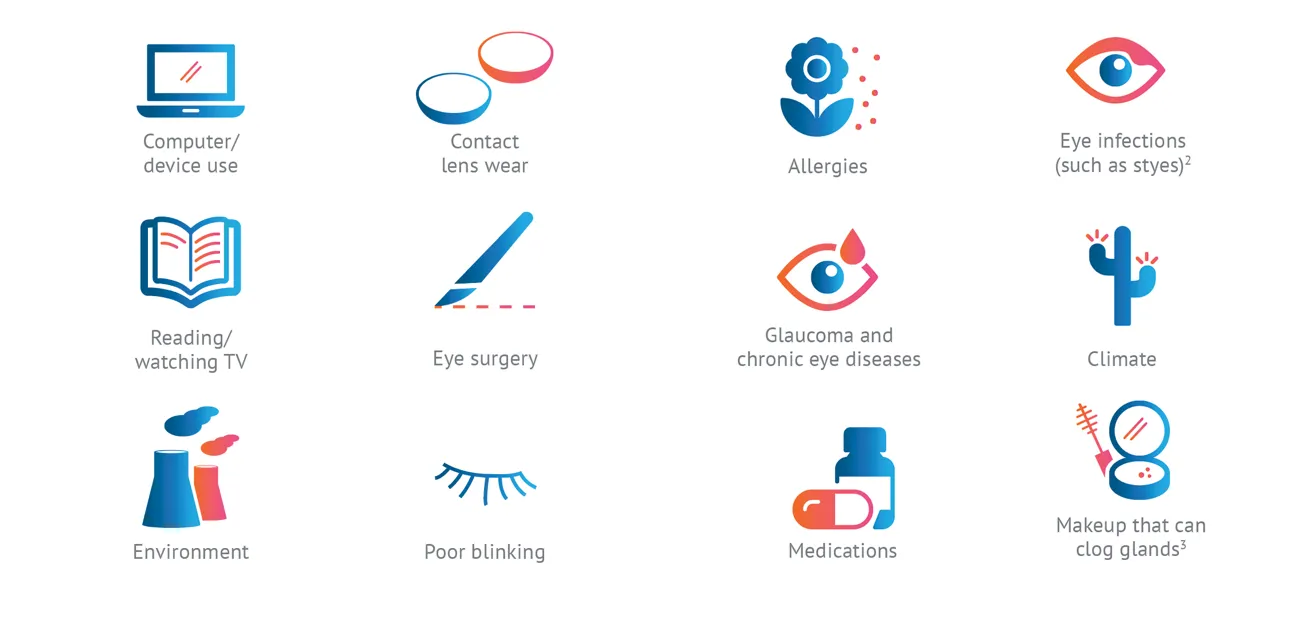MEIBOMIAN GLAND DYSFUNCTION
Meibomian Gland Dysfunction (MGD) is a leading cause of Dry Eye Disease, 86% of dry eye patients have MGD1, and yet it is very often overlooked.
Meibomian Gland Dysfunction (MGD) is a progressive disease of the ocular surface, and a leading cause of Dry Eye Disease. Healthy meibomian gland function reduces tear film evaporation, keeping your eyes moist and ensuring clear, comfortable, healthy, stable vision.
Long term, failure to treat MGD can lead to chronic discomfort and degradation of vision, significantly impacting quality of life.
Healthy Meibomian glands that line your upper and lower eyelids secrete oil with every blink. Your Meibomian glands produce the oily part of the tear film needed to protect the surface of your eye by preventing the evaporation of the watery part of your tears. When this function is not working well, your eyes may feel dry.


Symptoms of MGD include grittiness, watery eyes, itchiness, stinging, burning, blurred vision, heavy eyes, and light sensitivity.
However approximately 1 in 5 patients with MGD are asymptomatic.7 Because MGD progresses over time, keeping the function and structure of your Meibomian glands healthy before you become symptomatic is key.
WHAT CAUSED MGD?
MGD is caused by anatomical changes in the Meibomian glands. If left untreated, MGD can become progressively worse over time.
Conditions that can contribute to MGD:

Be proactive about your eye health and get screened. If you are diagnosed with MGD, TearScienceTM LipiFlowTM is a fast and easy in-office treatment that helps unblock the cause of MGD to get your glands functioning again. Treat the source of your dry eyes, not just the symptoms.
REFERENCES:
1. Lemp MA, Crews LA, Bron AJ, Foulks GN, Sullivan BD. Distribution of aqueous-deficient and evaporative dry eye in a clinic-based patient cohort: a retrospective study. Cornea. 2012;31(5):472-478.
2. Willcox MDP et al. TFOS DEWS II Tear Film Report. The Ocular Surface. 2017; 15:366-403.
3. Xiao J et al. Functional and Morphological Evaluation of Meibomian Glands in the Assessment of Meibomian Gland Dysfunction Subtype and severity. Am J Ophthalmol. 2020;209:160-67.;
4. Geerling G et al. Emerging strategies for the diagnosis and treatment of meibomian gland dysfunction – Proceedings of the OCEAN group meeting. The Ocular Surface. 2017;15:179-92;
5. Ye F,at el. Objective assessment of tear-film quality dynamics in patients with meibomian gland dysfunction and aqueous-deficient dry eye optical quality changes in different dry eye subtypes. Indian Journal of Ophthalmology. 2019;67(5):599-603
6. Nichols KK, Foulks GN, Bron AJ, Glasgow BJ, Dogru M, Tsubota K, Lemp MA, Sullivan DA. The international workshop on meibomian gland dysfunction: executive summary. Invest Ophthalmol Vis Sci. 2011 Mar 30;52(4):1922-9. doi: 10.1167/iovs.10-6997a. PMID: 21450913; PMCID: PMC3072157.
7. Viso E, et al. Prevalence of asymptomatic and symptomatic Meibomian Gland Dysfunction in the general population of Spain. Invest Ophthalmol Vis Sci. 2012; 53(6): 2601–2606. doi: 10.1167/ iovs.11-9228.
8. Lane SS et al. A New System, the TearScienceTM LipiFlowTM, for the Treatment of Meibomian Gland Dysfunction (MGD). Cornea. 2012;31(4):396-404. For illustrative purposes only. This content is presented for educational purposes only. JJSV Surgical Vision, Inc. does not engage in the practice of medicine and any clinical tips within this content are not a substitute for appropriate medical education and training or for the exercise of independent medical judgment. Each medical situation should be considered unique to each patient and all treatments individualized accordingly based on the respective physician’s medical judgment. JJSV Surgical Vision, Inc. does not (1) warranty the accuracy or completeness of any of the clinical tips, or (2) endorse or recommend any technique.
9. TearScienceTM LipiFlowTM IFU United States
10. Aggregate Global Sales Figures; LipiFlow at 700K treatments worldwide xlsx; Created Sep/9/2022; Data on File. Johnson & Johnson Vision Inc.
11. Blackie CA, Coleman CA, Holland EJ. The sustained effect (12 months) of a single-dose vectored thermal pulsation procedure for meibomian gland dysfunction and evaporative dry eye. Clin Ophthalmol. 2016; 10: 1385-1396.
12. Blackie CA, et al. A single vectored thermal pulsation treatment for meibomian gland dysfunction increases mean comfortable contact lens wearing time by approximately 4 hours per day. Clin Ophthalmol. 2018;12:169-183.
13. Matossian C, Chang DH, Whitman J, Clinch TE, Hu J, Ji L, Murakami D, Wang Y, Blackie CA. Preoperative Treatment of Meibomian Gland Dysfunction with a Vectored Thermal Pulsation System Prior to Extended Depth of Focus IOL Implantation. Ophthalmol Ther. 2023 Oct;12(5):2427-2439. doi: 10.1007/s40123-023-00740-x. Epub 2023 Jun 15. PMID: 37318707; PMCID: PMC10441955.

